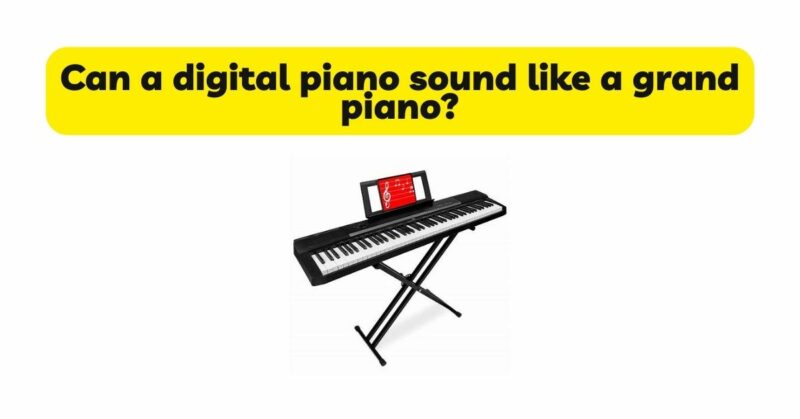In the realm of musical instruments, the digital piano has evolved to a point where it raises the question of whether it can truly replicate the majestic sound of a grand piano. In this article, we will delve into the capabilities and advancements of digital pianos in their quest to recreate the sonic qualities of grand pianos. By examining the technology, sound sampling, acoustic modeling, and innovative features of digital pianos, we aim to shed light on their ability to deliver a grand piano-like experience.
- Sound Sampling and Recording Techniques: Digital pianos employ sophisticated sound sampling techniques to capture the authentic sound of a grand piano. Samples are recorded from high-quality grand pianos using multiple microphones placed strategically to capture the nuances of each note. These samples are meticulously processed and stored within the digital piano’s memory. Through careful sampling, digital pianos can reproduce the timbre, tonal range, and dynamic qualities of a grand piano, bringing them closer to an authentic grand piano sound.
- Acoustic Modeling and Sound Reproduction: In addition to sound sampling, digital pianos utilize advanced acoustic modeling techniques to enhance their sound reproduction capabilities. Acoustic modeling algorithms simulate the physics of a grand piano’s sound production, including string resonance, sympathetic vibrations, and the interaction of sound waves with the instrument’s body. By incorporating these modeling techniques, digital pianos aim to replicate the natural resonances and complex harmonics that define the rich and immersive sound of a grand piano.
- Multi-Dimensional Sampling and Layering: Digital pianos often employ multi-dimensional sampling and layering techniques to further enhance their ability to mimic the sound of a grand piano. These techniques involve capturing samples at multiple dynamic levels, from soft to loud, and across various articulations. By layering these samples together in response to the player’s touch and playing style, digital pianos can recreate the nuanced and expressive qualities of a grand piano’s sound. The result is a more realistic and dynamic playing experience that closely resembles the responsiveness of a grand piano.
- Sound Design and Customization: Digital pianos offer sound design and customization options that enable musicians to tailor the instrument’s sound to their preferences. Users can adjust parameters such as brightness, resonance, sustain, and reverb to shape the tone and ambiance of the digital piano. These customization features allow pianists to refine the sound and emulate specific characteristics of different grand piano models. With careful adjustments, digital pianos can achieve a sound that closely resembles the unique tonal qualities of a grand piano.
- Speaker Systems and Amplification: The quality of the speaker system and amplification technology greatly impacts the ability of a digital piano to reproduce the sound of a grand piano convincingly. High-end digital pianos incorporate robust speaker systems, often with multiple speakers strategically positioned for optimal sound projection. These systems are designed to reproduce the full frequency range and dynamics of a grand piano, delivering a rich and immersive sound experience. When combined with advanced amplification technology, digital pianos can produce a sound that fills the room and emulates the powerful resonance of a grand piano.
- Room Acoustic Simulation: To enhance the realism of the grand piano sound, some digital pianos offer room acoustic simulation features. These features utilize advanced algorithms to recreate the sonic characteristics of different acoustic environments, such as concert halls, studios, or intimate spaces. By adjusting parameters such as reverberation and spatial imaging, digital pianos can create an immersive sound experience that mimics the acoustic ambiance of a grand piano in various settings.
- Limitations and Subjectivity: While digital pianos have made significant progress in replicating the sound of a grand piano, it’s important to acknowledge their limitations. Despite advancements in technology, capturing the full breadth and complexity of a grand piano’s sound is a challenging task. Factors such as the unique resonance of the grand piano’s body, the interaction of the strings with the soundboard, and the subtleties of touch response remain difficult to fully emulate. Additionally, personal perception and subjective preferences play a role in how closely a digital piano’s sound is perceived as matching that of a grand piano.
Conclusion: Digital pianos have come a long way in their pursuit of replicating the sound of a grand piano. Through advancements in sound sampling, acoustic modeling, multi-dimensional sampling, customization options, speaker systems, and room acoustic simulation, they have reached impressive levels of fidelity. While they may not fully match the complexity and nuances of a grand piano’s sound, high-quality digital pianos can provide an immersive and enjoyable playing experience that closely resembles the grand piano sound.
The decision to choose a digital piano over a grand piano should be based on individual needs, preferences, and circumstances. Digital pianos offer advantages such as versatility, portability, cost-effectiveness, and customization options that make them suitable for a wide range of musicians. They provide an accessible and convenient avenue for exploring the grand piano sound and expanding one’s musical horizons.
Ultimately, the quest to replicate the grand piano sound in a digital instrument is a continuous journey of innovation and refinement. As technology advances and our understanding of sound production deepens, digital pianos will continue to evolve, offering even closer approximations of the grand piano experience. Regardless of the instrument chosen, the joy of music-making and the artistry lies in the hands of the musician, and the digital piano can serve as a powerful tool for unlocking creativity and musical expression.


